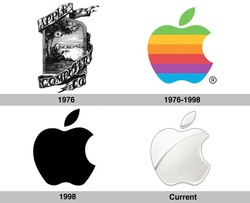
Looking to change your style at the bar tonight? Need to look more professional for work? Maybe you snag some new glasses or try a new hairstyle and add a little color. Even changing your t-shirt from round to v-neck can convey a different message about you. You're still you, just updated. Once in a while, the change elicits immediate reaction in others - whether positive or negative. Most of the changes you make though go unnoticed but add up and when you look back over time you realize how much you've changed - ideally for the better.
A company's brand can be similarly considered - especially companies that have been around for many years. A new look or tagline can mean reorienting employees, customers, and shareholders to the brand. A large change can also force stakeholders to take another look and reengage in a new and different way. Other smaller updates may be necessary to 'stay ahead of the curve' or 'keep up with the times'.
Paying attention to your brand and tagline as you evolve is critical to getting the attention you want from new and existing customers and the focus you want from your employees. A powerful brand, logo, and tagline can mobilize customers, employees, and shareholders toward the common goal of driving adoption and can keep you from becoming outdated, old, and not relevant.
The Decision to Change
Changing a brand of course isn't as easy as trying on a new shirt. In fact, given the costs involved in revising one and the fact that you can't really go back, it should be driven by thoughtful discussion across various functional groups in a company from marketing to engineering to customer service to sales and more. There is also the risk of upsetting loyal customers when you change a brand. If there is a strong emotional tie with the current brand, the change must be done in a way that brings those loyalists along and makes them love you even more.
Some reasons that may warrant a company changing its logo and/or tagline are:
Important Considerations When Changing A Brand
If a change is warranted, usually larger brands are careful not to sway too far from the original. The original brand has a lot of brand equity and people recognize it. Changing the brand drastically may mean losing that equity that you've built up. For some of those companies, at first glance, a customer may not even recognize a change. It can be subtle but powerful.
Other brands need a significant face lift. Getting a thoughtful designer who doesn't just execute but truly understands the company, its stakeholders, its goals, and its competitors is critical to any brand update. Doing your homework can make or break the launch of a new logo or tagline.
Communicating Your Brand
Significant time and effort should be taken on identifying the best way to communicate the changes of your brand. Most people underestimate how much change can impact someone. Change is usually a good thing in the long run, but in the short run it can elicit skepticism, disappointment, unhappiness, and downright anger in some cases. Companies need to consider if the change in brand elicits some sort of 'announcement' about it or not. If it's subtle, maybe it goes unnoticed. If it's a big change, it needs to be explained and you need to bring your customers along for the ride. Your customers may demand answers to questions such as 'why did the change happen?', 'what is the point of the change?', and 'how should we be thinking about the newly revised brand?'. It's also important to reiterate what hasn't changed and how the new brand still represents the amazing things about the company in terms of the values, the service, the products, etc. Change is tough to digest, so the more you can manage the change through effective communication, the more likely your customers will get on board with the changes faster.
Measuring Impact
Many people believe that brand impact cannot be measured and therefore should not be done. Impact can be measured in many ways - large companies hire agencies specifically designed to test out new brands, how they resonate with the stakeholders, how it may change buying behavior, and changes in things like market share, demographics, and acceptance in press and social media networks. Smaller companies can understand brand impact in terms of lifts in brand awareness. Looking at how many more people are searching for your brand is one way to see if you are driving improved awareness. Also understanding how those folks are converting and engaging with your brand overtime can help. Lastly, while not measurable, getting anecdotes from stakeholders as to how the new brand makes them feel and act is another way to understand whether or not the impact that you intended is actually occurring.
Good luck with the decision! Here's a great graphic of some changes big brands have made overtime. Think about how the changes some of these brands made may have impacted your life.
Let me know if you stopped by by adding a comment. Also tell me what else you want to hear about!!
A company's brand can be similarly considered - especially companies that have been around for many years. A new look or tagline can mean reorienting employees, customers, and shareholders to the brand. A large change can also force stakeholders to take another look and reengage in a new and different way. Other smaller updates may be necessary to 'stay ahead of the curve' or 'keep up with the times'.
Paying attention to your brand and tagline as you evolve is critical to getting the attention you want from new and existing customers and the focus you want from your employees. A powerful brand, logo, and tagline can mobilize customers, employees, and shareholders toward the common goal of driving adoption and can keep you from becoming outdated, old, and not relevant.
The Decision to Change
Changing a brand of course isn't as easy as trying on a new shirt. In fact, given the costs involved in revising one and the fact that you can't really go back, it should be driven by thoughtful discussion across various functional groups in a company from marketing to engineering to customer service to sales and more. There is also the risk of upsetting loyal customers when you change a brand. If there is a strong emotional tie with the current brand, the change must be done in a way that brings those loyalists along and makes them love you even more.
Some reasons that may warrant a company changing its logo and/or tagline are:
- the product line is different than what it was originally
- the company has evolved - startup logos tend to be more icon oriented, while larger brands focus less on icons and more on the actual name of the brand
- customer needs and/or demographics have changed
- overall the industry has changed and is higher 'tech', more 'modern', or the times have just...changed
- the brand is seen as seriously flawed in comparison with competitors
Important Considerations When Changing A Brand
If a change is warranted, usually larger brands are careful not to sway too far from the original. The original brand has a lot of brand equity and people recognize it. Changing the brand drastically may mean losing that equity that you've built up. For some of those companies, at first glance, a customer may not even recognize a change. It can be subtle but powerful.
Other brands need a significant face lift. Getting a thoughtful designer who doesn't just execute but truly understands the company, its stakeholders, its goals, and its competitors is critical to any brand update. Doing your homework can make or break the launch of a new logo or tagline.
Communicating Your Brand
Significant time and effort should be taken on identifying the best way to communicate the changes of your brand. Most people underestimate how much change can impact someone. Change is usually a good thing in the long run, but in the short run it can elicit skepticism, disappointment, unhappiness, and downright anger in some cases. Companies need to consider if the change in brand elicits some sort of 'announcement' about it or not. If it's subtle, maybe it goes unnoticed. If it's a big change, it needs to be explained and you need to bring your customers along for the ride. Your customers may demand answers to questions such as 'why did the change happen?', 'what is the point of the change?', and 'how should we be thinking about the newly revised brand?'. It's also important to reiterate what hasn't changed and how the new brand still represents the amazing things about the company in terms of the values, the service, the products, etc. Change is tough to digest, so the more you can manage the change through effective communication, the more likely your customers will get on board with the changes faster.
Measuring Impact
Many people believe that brand impact cannot be measured and therefore should not be done. Impact can be measured in many ways - large companies hire agencies specifically designed to test out new brands, how they resonate with the stakeholders, how it may change buying behavior, and changes in things like market share, demographics, and acceptance in press and social media networks. Smaller companies can understand brand impact in terms of lifts in brand awareness. Looking at how many more people are searching for your brand is one way to see if you are driving improved awareness. Also understanding how those folks are converting and engaging with your brand overtime can help. Lastly, while not measurable, getting anecdotes from stakeholders as to how the new brand makes them feel and act is another way to understand whether or not the impact that you intended is actually occurring.
Good luck with the decision! Here's a great graphic of some changes big brands have made overtime. Think about how the changes some of these brands made may have impacted your life.
Let me know if you stopped by by adding a comment. Also tell me what else you want to hear about!!


 RSS Feed
RSS Feed